The poster below shows the relative efficacy of different weed management tactics. It can also be found online at https://resources.ext.vt.
Tag: weed management
Critical Time for Managing Palmer Amaranth, Ragweed and other Herbicide Resistant Weeds
Ben Beale, Principal Agriculture Agent, St. Mary’s County & Kurt Vollmer, Weed Management Extension Specialist
University of Maryland
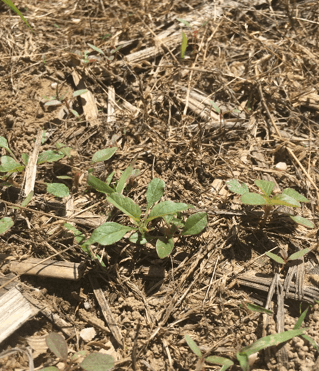
Palmer amaranth is now germinating in fields in Southern Maryland (Fig. 1), with the largest plants around 3 inches tall. The cool spring has slowed germination and plant growth this year. At the same time last year, Palmer amaranth plants were over 10 inches tall. Hot weather is returning this week so we can expect to see plants jump in size. In soybeans, now is the critical time to control Palmer amaranth plants before the crop emerges. The optimal size for effective control of this species is 3 to 4 inches. In fields that received a burndown herbicide application in May, expect to see additional plants emerging, often before the soybean crop is planted. Paraquat (Gramoxone® or generic alternatives) is an effective burndown treatment for smaller plants provided it is applied with adequate water to achieve good spray coverage. Other options include products like 2,4-D, saflufenacil (Sharpen®), or dicamba. Each of these products have plant-back restrictions. Glyphosate, while not effective on Palmer amaranth, can still be added to control other weeds. Our recommendation for controlling Palmer amaranth continues to be starting clean, using a residual herbicide with two modes of action at planting, and using a timely postemergence application around 24 days after planting. In our trials, products with flumioxazin (Valor®) including premixes of Fierce® or Fierce XLT® or products with sulfentrazone (Authority®) including premixes Broadaxe®, Authority Elite®, and Authority MTZ® provided the most consistent control. In 2020 trials, we evaluated 15 different herbicide programs in high-pressure sites. Bottom line—preemergence products containing either sulfentrazone or flumioxazin in combination with either metribuzin, pyroxasulfone, or S-metolachlor* provided excellent control for the first three weeks. When used in combination with an effective postemergent product such as Xtendimax® or Reflex® applied 24 days after planting, Palmer amaranth was effectively controlled with 0 plants present 60 days after planting. *S-metolachlor (Dual Magnum®) or dimethenamid (Frontier® or Outlook®) cannot be tank-mixed with Valor® within 14 days of planting soybeans, unless soybeans are planted under no-till or minimum-till on wheat stubble or no-till field corn stubble.
Integrating several strategies into your weed management plan will help avoid resistance and increase control. Effective strategies include crop rotation, tillage, seed bank management, preventing seed movement, use of cover crops, narrow rows (15 inches or less) and managing the crop to promote competitive growth and quick canopy closure.
Common Ragweed and Marestail:
We have already started to receive calls about controlling ALS- and glyphosate-resistant ragweed and marestail in emerged soybeans. Unfortunately, we don’t have any of good options for control once beans are up. The only option for ALS- and glyphosate-resistant ragweed in conventional or Roundup Ready® soybean is fomesafen (Reflex® or Flexstar®).
Marestail plants are beginning to bolt in Southern Maryland (Fig. 2). Most marestail is resistant to glyphosate and ALS products. As with ragweed and Palmer, it is critical to control marestail before planting.
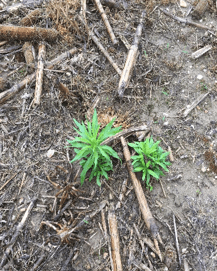
Unfortunately, post emergent PPO products, such as Reflex® or Cobra®, do not control marestail. In ALS- resistant populations, there are few options once beans emerge. Burndown options include glyphosate plus 2,4-D (1 qt/A), glyphosate plus dicamba or glyphosate plus Sharpen®, will effectively control glyphosate- and ALS-resistant populations when they are less than 4 inches tall. Plant back restrictions apply. Liberty® or Gramoxone® are also options for small marestail and do not have any plant back restrictions.
If you planted one of the tolerant herbicide platforms like RR2 Xtend® (dicamba, glyphosate); LibertyLink® (glufosinate); LibertyLink GT27® (glufosinate, glyphosate, HPPD); or Enlist E3® beans (2,4-D, glyphosate, glufosinate) you have an additional option for early control. With the increase in availability of different herbicide tolerance platforms, it is important that producers carefully record where each variety is planted to avoid application mistakes. Glufosinate will kill Xtend® soybeans, and dicamba will kill Enlist, LibertyLink® and Liberty Link GT® beans. A couple of reminders to increase control. Contact products such as Liberty®, Reflex® and Cobra® require good spray coverage to achieve control so use at least 15 gallons of water per acre. Liberty works best when applied in full sunlight. All POST products including Liberty®, dicamba, 2,4-D, Reflex®, Cobra®, and Ultra Blazer® are most effective when weeds are 4 inches tall or less.
More information on management of Palmer amaranth is available here: https://extension.umd.edu/sites/extension.umd.edu/files/_docs/publications/Palmer%20Amaranth%20in%20MD%20FS-1086%20%281%29.pdf
More information on management of Common Ragweed is available here: https://extension.umd.edu/learn/publications/managing-herbicide-resistant-common-ragweed
Proactive Measures to Combat Herbicide-Resistant Common Ragweed
Sarah Hirsh, Agriculture Agent
University of Maryland Extension, Somerset County
In the next couple of weeks, common ragweed will begin to emerge (Figure 1). There are herbicide-resistant populations of common ragweed throughout Maryland. In 2019, common ragweed samples from St. Mary’s, Charles, Somerset, Worcester, and Wicomico counties, MD were tested and found to be resistant to glyphosate (group 9) and cloransulam (Firstrate; group 2 “ALS Inhibitors”) herbicides. Furthermore, three-way resistance to glyphosate, Firstrate, and fomesafen (Reflex, group 14 “PPO Inhibitors”) was found for two eastern shore samples from Dorchester Co, MD and Kent Co, DE. Because common ragweed populations can be resistant to glyphosate and other herbicides, pre-planting and residual herbicide control are particularly important.
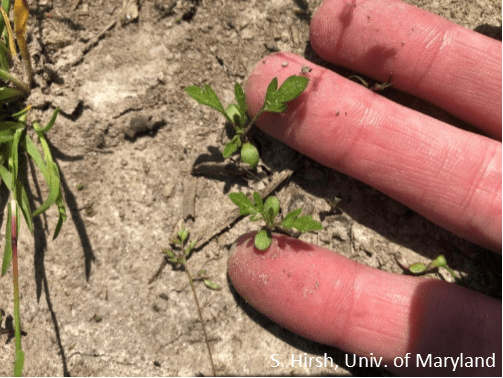
What steps can you take now against common ragweed?
- Delay cover crop burn down. In addition to providing other agronomic benefits, cover crops may provide competition with spring weeds, including ragweed, and reduce emergence and growth. Growing conditions have been excellent this spring, so terminating a cover crop would leave an open window for weeds to proliferate.
- Plan to apply something other than or in addition to glyphosate at pre-planting burndown. Research trials in 2019 indicated that a herbicide burndown of glyphosate plus Liberty at soybean planting effectively eliminated common ragweed. (Soybean was planted 18 May at one site and 3 June at a second site). The addition of 2,4-D or Banvel is another glyphosate tank mix option, and paraquat or paraquat + metribuzin is another option for smaller ragweed plants.
- Apply a residual herbicide at soybean planting. Research trials in 2019 indicated that it was important to apply a residual herbicide at burndown to control post-planting common ragweed escapes. Applying the residual herbicide at soybean planting provided better common ragweed control than applying the residual herbicide at an earlier (4 April) burndown date. A second research trial comparing residual herbicide products found that Command, Linex, Dimetric, or combinations of Command + Dimetric, and Linex + Dimetric all reduced common ragweed prevalence in soybean.
More information on managing herbicide-resistant common ragweed in Maryland can be found here: https://extension.umd.edu/sites/extension.umd.edu/files/_docs/publications/Ragweed%20FS474.pdf

Common ragweed can quickly get out of hand and dominate a soybean crop (Figure 2). However, with proactive control and scouting, herbicide-resistant common ragweed can be effectively controlled.
Spring Weed Control for Pasture and Hayfields
Dr. Amanda Grev, Pasture & Forage Specialist
University of Maryland Extension
As things are greening up this spring, you may notice a few not-so-friendly plants popping up around your fields, especially given the milder weather this past winter. If you haven’t already done so, now is the time to scout your pastures and hayfields in search of winter annual and biennial weeds. When it comes to weed control, timing of herbicide application is critical and it is important to spray when weeds are most susceptible to achieve maximum effectiveness.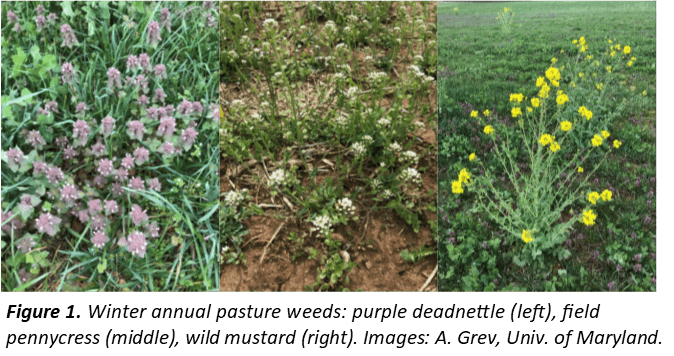
Winter annuals typically germinate in the fall, overwinter, and complete their reproductive cycle in the spring or early summer. Common winter annual species include chickweed, purple deadnettle, field pennycress, henbit, horseweed/marestail, shepherd’s purse, and the mustard species. Annuals are best controlled during the seedling and early vegetative stage when they are young and actively growing. Herbicide applications will be more effective if made at this stage while they are still vegetative and more susceptible and will prevent them from flowering and producing seed. At this time of year, these winter annuals are growing rapidly and have already or will soon begin to flower and set seed. If the winter annuals in your fields have moved beyond this stage, an application may offer some control but you may also want to take note of those weedy areas now and target them later this year with a late fall application.
Biennials live for two growing seasons, with the first year consisting of only vegetative growth as a seedling and rosette and the second year consisting of vegetative growth and also reproductive growth in the form of an elongated flower stalk. Common biennial species include burdock, bull thistle, musk thistle, and wild carrot. These weeds are best controlled during the seedling and rosette stage, and should be treated now while they are smaller and more susceptible and before they begin to bolt.
There are a number of herbicides available for control of broadleaf weeds. Herbicide selection should be based on the type of forage and weed species present. The most common herbicides used for control of broadleaf weeds in grass hay or pasture are the plant growth regulator herbicides, which includes products containing 2,4-D, dicamba, triclopyr, aminopyralid, picloram, or a mix of these (see the table below for a list of common products). These products are safe if applied to grass forages at the labeled rates but can kill or injure desirable broadleaf forages (i.e. clover) in grass-legume mixed pastures.
If weedy annual grasses such as crabgrass, foxtail, panicum, and Japanese stiltgrass are problematic, pendimethalin (Prowl H2O) now has a supplemental label that allows for its use on established perennial pastures or hayfields grown for grazing, green chop, silage, or hay production. It may be applied to perennial grass stands or alfalfa-grass mixed stands. Prowl H2O may be applied as a single application in the early spring, or for more complete control it can be applied as a split application with the first application in early spring and the second application after first cutting. Keep in mind, this herbicide is a pre-emergent herbicide, meaning it will only control weeds if applied prior to germination. If soil temperatures in your area are already above 50°F it is likely that crabgrass and stiltgrass has already germinated, but a split application of Prowl H2O now and after first cutting can help control foxtail. There are currently no herbicides labeled to control emerged weedy grasses in grass stands or alfalfa/grass mixes.
Note that if forages were recently seeded and are not yet established many of these herbicides can cause severe crop injury. Most herbicide labels for cool-season perennial grasses state that the grasses should be well established with at least 4-5 inches of growth, although some labels are more restrictive than this. In addition, some of these herbicides have haying or grazing restrictions following application. Always read and follow the guidelines listed on the product label for proper rates, timing, residual effects, and any grazing or harvest restrictions following application.
Lastly, remember that while herbicides can be a useful tool for weed management in pastures and hayfields, they are not the only option for weed control. A program that integrates several different control strategies is generally more successful than relying on a single method. For maximum results, include cultural practices such as selecting adapted species and maintaining optimum soil fertility, mechanical practices such as timely mowing or clipping to suppress weed seed production, and biological practices such as utilizing livestock for controlled grazing or browsing. And remember that weeds are opportunistic; the best method for weed control is competition with a healthy, dense stand of desirable forage species.
| Product | Active Ingredients | Application Rate* | General/Restricted Use |
| 2,4-D | 2,4-D | 1 to 2 qt/A | General |
| Banvel/Clarity | dicamba | 0.5 to 2 pt/A | General |
| Crossbow | 2,4-D + triclopyr | 1 to 6 qt/A | General |
| GrazonNext HL | 2,4-D + aminopyralid | 1.2 to 2.1 pt/A | General |
| Grazon P+D | 2,4-D + picloram | 2 to 8 pt/A | Restricted |
| Milestone | aminopyralid | 3 to 7 fl. oz/A | General |
| PastureGard HL | triclopyr + fluroxypyr | 0.75 to 4 pt/A | General |
| Prowl H2O | pendimethalin | 1.1 to 4.2 qt/A | General |
| Remedy Ultra 4L | triclopyr | 0.5 to 4 pt/A | General |
| Stinger | clopyralid | 0.7 to 1.3 pt/A | General |
| Surmount | picloram + fluroxypyr | 3 to 6 pt/A | Restricted |
| WeedMaster | 2,4-D + dicamba | 1 to 4 pt/A | General |
*For use in established grass pasture or hayfields
New UMD Weed Management Specialist

Meet Dr. Kurt Vollmer! Kurt joined the University of Maryland Extension Team in September and serves as the new Weed Management Specialist. A native of Richlands, VA, Kurt completed his undergraduate degree in Biology at Emory and Henry College in Virginia, followed by a brief stint as an environmental educator at the YMCA Camp Thunderbird Environmental Education Center, in South Carolina. Kurt received his M.S. degree in Agronomy with a concentration in Weed Science at the University of Florida, and his Ph.D. in Weed Science at Virginia Tech. In addition, he recently completed a post-doc at the University of Delaware Carvel Research and Education Center with Dr. Mark VanGessel. Kurt’s research has encompassed a wide variety of subjects including weed physiology, herbicide efficacy, herbicide resistance, and integrated weed management. Kurt’s office is located at the Wye Research and Education Center in Queenstown. Kurt can be reached by phone at (410) 827-8056 or by email at kvollmer@umd.edu.
Palmer Amaranth and Waterhemp Management At Harvest
Kelly Nichols, Agriculture Agent Associate
University of Maryland Extension, Frederick County
This summer, we have gotten a few calls about Palmer amaranth and waterhemp, two pigweed species that are unfortunately becoming more common. These two pigweeds are difficult to control, mostly due to their herbicide resistance and fast growth (especially in hot weather). Often, these pigweeds are not noticed until they are seen growing up over the crop canopy, especially in soybeans. By then, it is too late to control them.

As we head into harvest, if you have Palmer or waterhemp – or want to make sure you don’t have them – scout your fields to be certain. Know how to identify Palmer (Figure 1) and waterhemp (Figure 2). The main characteristic is that these two troublesome pigweeds are completely hairless. Redroot and smooth pigweed, our most common pigweed species, have hairs on the stems and leaves. Another characteristic of Palmer is that the petiole (the little stem that attaches the leaf blade to the main stem) is longer than the leaf blade itself. (Note: Spiny amaranth, or spiny pigweed, is another pigweed that is common in pastures. It also does not have hairs; however, it will have spines on the stem. Palmer and waterhemp do not have these spines).
While you are scouting, pull out the Palmer or waterhemp plants (as many as you can). Palmer and waterhemp can produce hundreds of thousands of seeds per plant. At this point in the season, this is the best way to reduce the number of seeds that could germinate next year. Consider taking a paper bag with you to put the plants in, as smaller plants can re-root. Take the plants out of the field and bury or burn them.
Harvest infested fields last. The biggest concern with harvesting infested fields is the spread of the seeds – not only throughout the currently infested field, but also to other fields and possibly other farms. If there is only a small section of the field that is infested, consider not harvesting that section to avoid spreading the seeds. If you are not running the combine, be in communication with the person who is to ensure that Palmer or waterhemp seeds are not brought onto your farm and/or spread around your fields. If the infested harvested crop is to be fed to livestock, the processes of grinding, roasting, and ensiling can destroy weed seeds and prevent the seeds from being spread in the manure.
After harvest (or in between fields if necessary), clean out the combine. Pigweed seeds are tiny (about the size of a pencil point), and it is difficult to perfectly clean out a combine. However, cleaning can still reduce the number of weed seeds in the combine. Use compressed air and start at the front of the combine, working up to the grain tank and auger, and then to the back. Running straw through the combine can also help to clean it out. Research from the University of Delaware has shown that using compressed air in combination with running straw through the combine can potentially reduce the number of weed seeds in the combine by thousands.

For next year, consider using these strategies to control Palmer and waterhemp: plant a cover crop to provide weed suppression in the spring; rotate to corn for more effective herbicide options (compared to soybeans) or a perennial forage; use the full recommended labeled rate; use residual herbicides in both the pre- and post-emergence applications, as Palmer and waterhemp seeds can germinate throughout the growing season; use multiple effective modes of action; and rotate modes of action. More information on Palmer and waterhemp, as well as herbicide resistance weed management, can be found at www.integratedweedmanagement.org, a website run by Extension Weed Specialists from across the U.S.
Palmer Amaranth is Out and About—Are You Ready?
Ben Beale, Senior Agriculture Agent
University of Maryland Extension, St. Mary’s County
We observed Palmer amaranth germinating in fields in Southern Maryland the first week of May. These plants are now exceeding the optimal height for control. Plants are now 8-10 inches tall in fields that did not receive any burn down treatment or tillage this spring. The optimal size for effective control of palmer is 3 to 4 inches.

In fields that received a burn down herbicide application in May, expect to see additional plants emerging, often before the soybean crop is planted. Be sure to kill these plants before the soybeans emerge. Paraquat (Gramoxone® or generic alternatives) is an effective burn down treatment for smaller plants provided it is applied with adequate water and spray coverage is adequate.

Other options include products like 2,4-D, saflufenacil (Sharpen®), or dicamba. Each of these products have plant-back restrictions. Glyphosate, while not effective on Palmer amaranth, can still be added to control other weeds present. Integrating several strategies into your weed management plan will help avoid resistance and increase control. Effective strategies include crop rotation, tillage, seed bank management, preventing seed movement, use of cover crops, choosing a residual herbicide program with at least two effective modes of action and use of timely post-emergent herbicide applications.
More information on management of palmer amaranth is available from University of Maryland Fact Sheet 1086, Palmer Amaranth in Maryland.
Job Opening: Weed Management Specialist
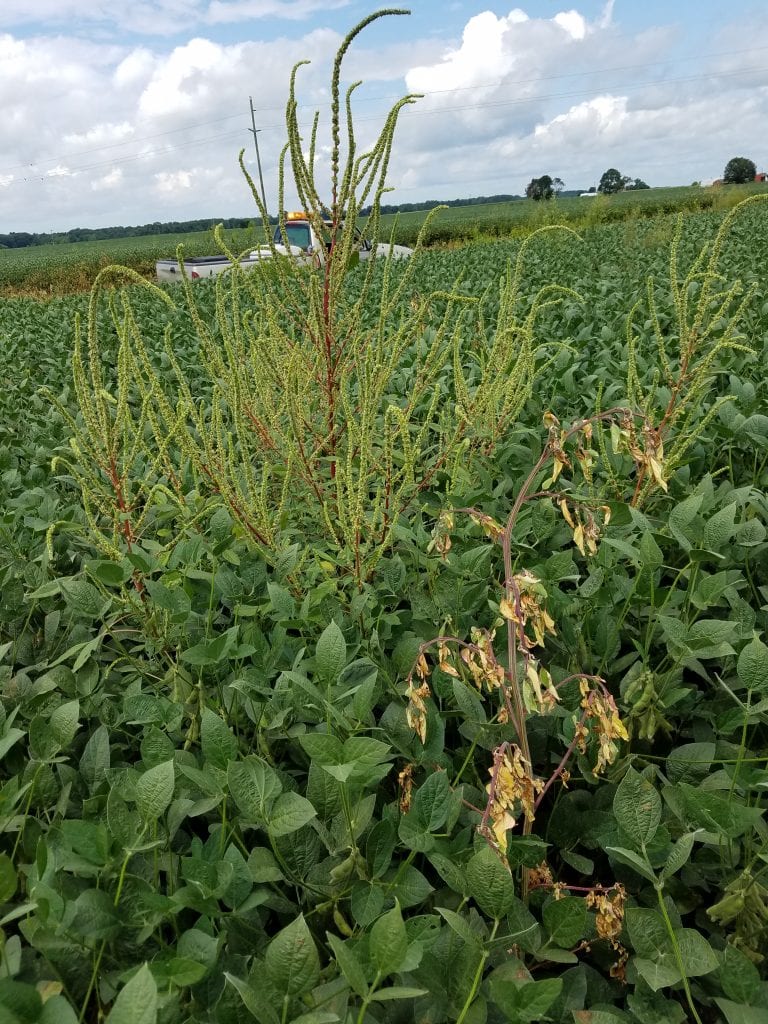
University of Maryland Extension is searching for a weed management specialist. Interested candidates should apply online at ejobs.umd.edu and search for position #103680. Apply by May 11, 2019.
2019 Herbicide Resistant Weeds Workshops
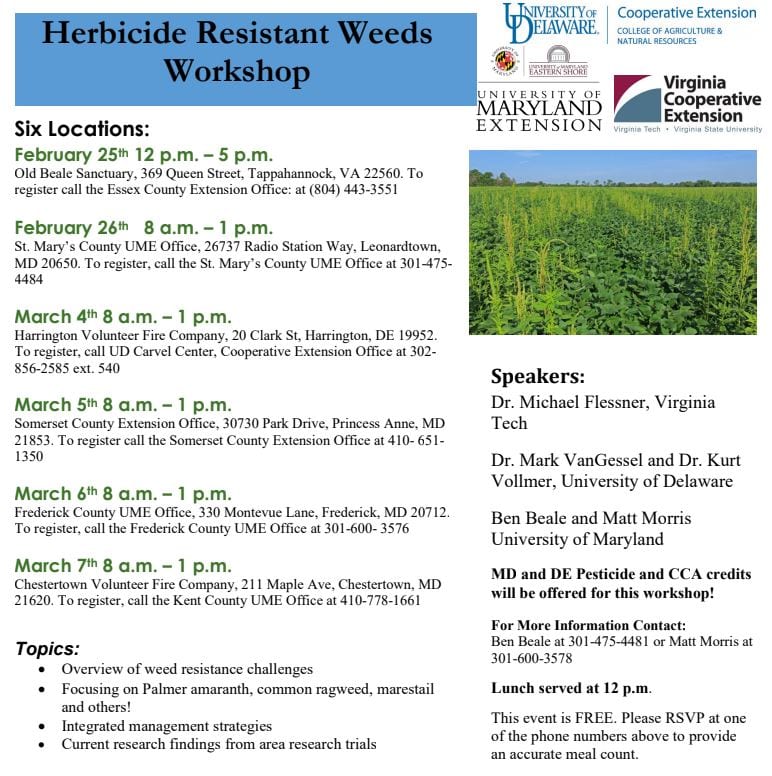
Controlling Perennial Weeds in No-Till Fields
Kelly Nichols, Agriculture Agent Associate
University of Maryland Extension, Frederick County
kellyn@umd.edu
Perennial weeds like pokeweed, hemp dogbane, and horsenettle can flourish in no-till corn and soybean fields. Without tillage to break up the roots, perennial weeds can continue to regrow every year. Here are a few tips on how to control perennial weeds in your fields.

Use a residual herbicide to prevent seedlings from germinating later in the summer. Those later-emerging seedlings may still have time to become established enough to survive the winter and re-grow the following spring.
Apply post-emergent herbicides at the proper time. About the time that the perennial weeds are producing flower buds and blooms (approximately mid-summer), they begin to send food reserves down to the roots. Since things are moving in a downwards direction in the plant, the herbicide is more easily taken down to the roots, which will provide better control. A late post-emergent application is more possible in soybeans, which are a shorter-statured plant. One benefit from the wet spring and late-planted fields is that the corn is shorter than normal at this time of year, making a late post-emergent herbicide application possible in corn as well.
Rotate the field into other crops. In an alfalfa field, perennial weeds will not be able to withstand the frequent mowing. It depletes the food reserves in the root, weakens the plant, and reduces the chance for winter survival. Small grains that are harvested for grain will compete with the perennial weeds trying to grow in the spring and summer. An herbicide application could follow the harvest to control any late-summer weed emergence.
The Mid-Atlantic Field Crop Weed Management Guide provides herbicide recommendations and information for agronomic crops. To purchase a pdf or hard copy, visit the Penn State Extension website. To view a low-resolution pdf for free, visit the University of Delaware Extension website